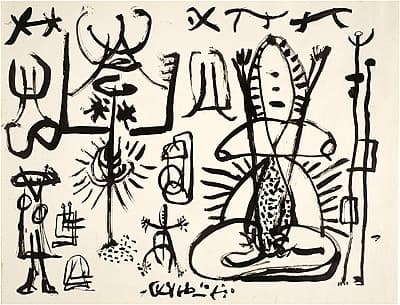
Jackson
POLLOCK
United States of America
1912
–
1956
Untitled
1939-42
brush and ink
on paper
OT 609
no inscriptions
sheet
34.7 (h)
x 45.4 (w)
cm
framed
54.7 (h)
x 74.2 (w)
cm
Purchased 1986
National Gallery of Australia, Canberra
NGA 1986.1050
© Pollock/Krasner Foundation/ARS. Licensed by Viscopy
- estate of the artist;
- estate of Lee Krasner Pollock;
- from whom bought, though Jason McCoy, New York on behalf of the Trustees of the Estate of Lee Krasner Pollock, by the Australian National Gallery, February 1986
- Drawings by Jackson Pollock
- Sidney Janis Gallery 04 Nov 1957 – 30 Nov 1957
- Jackson Pollock
- Kunsthalle, Dusseldorf 05 Sep 1961 – 08 Oct 1961
- Jackson Pollock
- Kunsthalle, Zurich 24 Oct 1961 – 29 Nov 1961
- Jackson Pollock
- Marlborough Galleria d'Arte, Rome 1962-10- – 1962-11-
- Jackson Pollock
- Toninelli Arte Moderno, Milan 1962-11- – 1962-12-
- Jackson Pollock: Black and White
- Marlborough - Gerson Gallery Inc., 1969-03- – 1969-03-
- Jackson Pollock's Blue poles
- National Gallery of Australia 04 Oct 2002 – 27 Jan 2003
- Abstract Expressionism: the National Gallery of Australia celebrates the centenaries of Jackson Pollock and Morris Louis
- 14 Jul 2012 – 24 Feb 2013
- Eugene Thaw and Francis O'Connor, Jackson Pollock: Catalogue raisonné of paintings, drawings and other works, New Haven and London: Yale University Press 1978. cat. 609. p. 150, illus. b&w;
- Anthony White (ed.), Jackson Pollock’s Blue poles, Canberra: National Gallery of Australia 2002, cat. 26, p. 19, p. 118, illus. b&w, p. 93
The coloured ink and gouache, and the associated black ink study, are examples of Jackson Pollock’s early drawings, created before the recognition of him as an artist that followed his first solo exhibition in 1943. Both drawings reveal a complex combination of historical, aesthetic and psychological influences. By the late 1930s Pollock had made a deliberate break from the Regionalism of Thomas Benton, and was working for the Works Progress Administration.[1] Simultaneously, his growing interest in both the techniques and subject matter of Surrealism, combined with the psychological theories of Carl Jung, resulted in a creative outpouring: between 1938 and 1943, Pollock produced numerous pictographic drawings based on striking symbolic motifs.
The coloured study reveals the influence of the Mexican muralists David Alfaro Siqueiros, José Clemente Orozco and Diego Rivera, all of whom were active in New York during the 1930s.[2] By dividing the composition into four separate sections, Pollock’s study can be interpreted as a loose narrative presented across an elongated format, not dissimilar to the Mexican murals being created in New York at the time. Whilst the style of the drawing—comprising of blockish forms, each of which is defined by a linear black outline—echoes the street-style of Mexican political murals, we can also detect the iconographic influence of African, Oceanic, Melanesian and Native American Indian art.
A number of European Surrealists had fled to New York at the outbreak of the Second World War. Their presence had an enormous impact on the first generation of Abstract Expressionists, many of whom adopted Surrealist ideas and techniques, including an interest in Jungian theory and automatic drawing. At the same time, Pollock read, and was immediately struck by, the theories of John D. Graham. In his influential essay, ‘Primitive art and Picasso’, Graham explored the potent connection between indigenous art and modern abstraction in terms of the Jungian collective unconscious.[3] Pollock was to form a close relationship with the writer, and his collection of African, Oceanic and Melanesian objects was an immediate source of inspiration for the younger artist. Both of Pollock’s drawings include numerous totemic figures, recurring masks, forms of animism, lightning motifs and linear patterning that are directly influenced by such sources.
The drawings also display special meaning in terms of Jungian psychology. At the time of their production, Pollock was undergoing treatment for his alcoholism and, through his drawings, seeking a deeper understanding of his personal and psychological problems. Using Jungian theory to decipher Pollock’s drawings, the artist’s treating psychologist, Joseph Henderson, made special mention of the recurring motif of the ‘humanoid form with extended arms’—present on the far left of the coloured study and again as the central, cross-legged pictogram in the black ink study—as a visual referent connected with a ‘longing for the all-giving mother’.[4] Furthermore, the use of red, blue and yellow in the coloured study can be interpreted along Jungian lines as representing a number of identified human functions: intuition, thinking, sensing and emotion.
Jaklyn Babington
[1] Pollock studied under Thomas Benton at the Art Students League, and worked for the mural division of the Works Progress Administration (WPA)—a government program that employed artists during the Depression—between 1938 and 1942.
[2] Pollock participated in Siqueiros’ 1936 workshop, an experience which persuaded him that large mural-like work was vital for the future direction of painting.
[3] John D. Graham, ‘Primitive art and Picasso’, Magazine of Art, 1937
[4] Joseph Henderson, M.D. ‘Jackson Pollock: A psychological commentary’, unpublished essay as cited in C.L. Wysuph, Jackson Pollock: Psychoanalytic drawings, New York: Horizon Press 1970, p. 17
As well as the two paintings by Pollock, Totem Lesson 2 1945 and Blue poles 1952, the National Gallery of Australia holds six drawings from the 1930s and 1940s, and two sets of prints: six intaglio prints c.1944, printed 1967, and six screenprints 1950.
